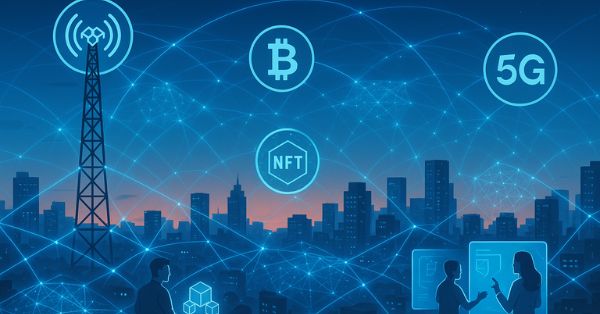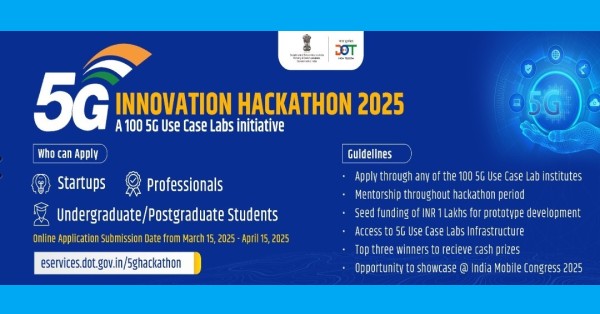India’s Department of Telecommunications (DoT) has renewed its effort to gauge industry appetite for directly assigned spectrum to set up private 5G networks. This latest move revives an earlier plan that had lost momentum due to device ecosystem limitations and concerns raised by mobile operators.
Fresh Demand Survey for Private 5G Spectrum by India's DoT
On June 30, the DoT issued a notifica…
Home » Agriculture
Agriculture
Essential insights and practical tools for navigating private networks. Get Details.
Available on Amazon & Google Books
Subscribe To Our Newsletter
- Tech News & Insight
- July 2, 2025
- Hema Kadia
India’s Department of Telecommunications (DoT) has relaunched its plan to directly allocate spectrum for private 5G networks. The new demand study invites large enterprises and system integrators to signal interest in dedicated spectrum for captive 5G setups. If approved, this policy could enable Indian industries to run secure, high-speed networks without fully relying on telecom operators.
- Tech News & Insight
- June 27, 2025
- Hema Kadia
- Tech News & Insight
- May 27, 2025
- Hema Kadia
Web3 is redefining the telecom industry by introducing decentralized infrastructure, blockchain-based billing, smart contracts, NFTs, and digital identity. This article explores how telcos can evolve from connectivity providers to key players in Web3 ecosystems—offering programmable services, token economies, and secure, user-centric digital experiences.
- 5G, 6G, AI, AR, Blockchain, Edge/MEC, IoT, Metaverse, Sustainability, VR
- ATT, CBRS, China Mobile, Crypto, Dish Network, Fiber, Investment, LTE, MTN, NFT, Policy, SKT, Spectrum, T-Mobile, Telefonica, Verizon, Web3
- Agriculture, Education, HealthCare, Media and Broadcast, Retail, Telecom
- Tech News & Insight
- April 29, 2025
- Hema Kadia
The fiber, data center, and telecom sectors are evolving rapidly amid rising AI workloads, cloud expansion, edge computing, and new investment models. This article breaks down the key trends — from fiber deployments in rural markets to secondary data center expansions and telecoms shifting to platform-based services, that are reshaping digital infrastructure for a hyperconnected future.
- Tech News & Insight
- April 22, 2025
- Hema Kadia
Indian telecom companies such as Jio and Airtel are moving beyond internal AI use cases to co-develop monetizable, India-focused AI applications in partnership with tech giants like Google, Nvidia, Cisco, and AMD. These collaborations are enabling sector-specific AI tools across healthcare, education, and agriculture, boosting operational efficiency, customer experience, and creating new revenue streams for telecom operators.
- Tech News & Insight
- March 23, 2025
- Hema Kadia
Telecom providers have spent over $300 billion since 2018 on 5G, fiber, and cloud-based infrastructure—but returns are shrinking. The missing link? Network observability. Without real-time visibility, telecoms can’t optimize performance, preempt outages, or respond to security threats effectively. This article explores why observability must become a core priority for both operators and regulators, especially as networks grow more dynamic, virtualized, and AI-driven.
- News
- March 17, 2025
- Hema Kadia
The Department of Telecommunications (DoT) has announced the 5G Innovation Hackathon 2025, a six-month competition to drive 5G-powered solutions across industries. Open to students, startups, and professionals, the hackathon will focus on AI, IoT, smart cities, and next-gen connectivity innovations. Participants will receive funding, mentorship, and access to 100+ 5G Use Case Labs. Winners will showcase their solutions at India Mobile Congress 2025.
- Usecase
- January 22, 2025
- Hema Kadia
Freshwave’s portable 5G private network, deployed at the National Robotarium, is advancing Industry 4.0 and agritech through real-time robotics applications. Leveraging n77 spectrum, the network enables precision agriculture and scalable IoT solutions, overcoming challenges in rural connectivity and data processing.
- Podcast
- December 26, 2024
- Hema Kadia
Trilogy Networks is revolutionizing agritech with private 5G, addressing rural connectivity gaps and enabling precision farming. By integrating IoT, edge computing, and advanced analytics, Trilogy supports real-time decision-making, sustainable practices, and automation in agriculture. Learn how Trilogy’s standardized, scalable solutions are paving the way for a more connected future in agriculture and beyond.
- Article & Insights
- November 15, 2024
- Hema Kadia
TeckNexus is proud to announce the winners of the 2024 Private Networks Awards, celebrating outstanding achievements in private 5G, LTE, and CBRS innovations. This prestigious program honors companies, solutions, and collaborations that have transformed connectivity and redefined industry standards in sectors such as manufacturing, healthcare, smart cities, and public safety. The winners showcase how advanced private networks and strategic partnerships address complex challenges, drive innovation, and promote sustainable growth.
Whitepaper
Telecom networks are facing unprecedented complexity with 5G, IoT, and cloud services. Traditional service assurance methods are becoming obsolete, making AI-driven, real-time analytics essential for competitive advantage. This independent industry whitepaper explores how DPUs, GPUs, and Generative AI (GenAI) are enabling predictive automation, reducing operational costs, and improving service quality....

Whitepaper
Explore the collaboration between Purdue Research Foundation, Purdue University, Ericsson, and Saab at the Aviation Innovation Hub. Discover how private 5G networks, real-time analytics, and sustainable innovations are shaping the "Airport of the Future" for a smarter, safer, and greener aviation industry....

Article & Insights
This article explores the deployment of 5G NR Transparent Non-Terrestrial Networks (NTNs), detailing the architecture's advantages and challenges. It highlights how this "bent-pipe" NTN approach integrates ground-based gNodeB components with NGSO satellite constellations to expand global connectivity. Key challenges like moving beam management, interference mitigation, and latency are discussed, underscoring...

Download Magazine
With Subscription
Subscribe To Our Newsletter
Executive Interviews
Brand Connect
Amplify Your Brand & Boost Your Business
- Thought-Leadership Management
- Magazine Article
- Executive Interviews
- Whitepapers
- Research Reports
- Custom Research
- Blog Series
- Webinars
- Podcasts
- Advertorials
- Display Ads
- Event Partnership































